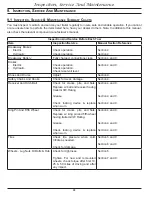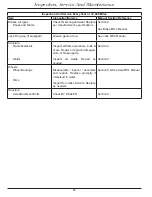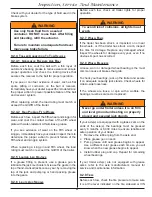
33
these instructions, contact your dealer for assistance.
Normally, dump trailers use the hoist battery to provide
power to the breakaway brakes. If your trailer is not
setup this way, there will be a small breakaway battery
mounted near the breakaway switch.
Most trailers are setup to charge the battery from
the tow vehicle. If the electrical system on your tow
vehicle does not provide power to the battery, you
must periodically charge the battery with a commercial
battery charger to keep the battery charged.
^
CAUTION
Extreme cold weather can degrade battery
performance and cause brakes to not
operate properly.
Check battery charge level before towing.
Do not tow trailer if the battery requires recharging. A
discharged brake battery will not activate the brakes if
the trailer uncouples from the tow vehicle. The battery
must be fully charged before towing trailer.
To test the breakaway brake battery, remove the pullpin
from the switch and attempt to pull the trailer forward.
You should feel the trailer resisting being towed, but
the wheels will not necessarily be locked. If the brakes
do not function, do not tow the trailer until brakes, or
battery, are repaired.
Immediately replace the pullpin. The breakaway
brake battery discharges rapidly when the pullpin is
removed.
^
WARNING
An ineffective breakaway brake system can
result in a runaway trailer, leading to death
or serious injury if the king pin fails.
Test the function of the breakaway brake
system before towing trailer. Do not tow
trailer if breakaway brake system is not
working; have it serviced or repaired.
Connect breakaway lanyard to the tow
vehicle, NOT to the fifth wheel or its
support.
Do not tow the trailer with the breakaway brake system
ON because the brakes will overheat which can result
in permanent brake failure.
4.3.2.8 u
ncouple
t
raIler
w
Ith
k
Ing
p
In
Follow these steps to uncouple trailer from the tow
vehicle:
1.
Park the trailer on a firm level surface and block
trailer tires.
2.
Lower tow vehicle tailgate if equipped.
3.
Disconnect electrical connector.
4.
Disconnect breakaway brake switch lanyard.
5.
Before extending jack, make certain the ground
surface below the jack pad will support the tongue
load.
^
CAUTION
Drop leg jacks may be spring loaded.
If so, they will rapidly return to the raise
position when released.
Keep clear when releasing drop legs.
6.
Lower jack drop leg if equipped.
7.
Rotate jack handle to extend the jack to transfer
some of the weight of the trailer to the jack.
8.
Open fifth wheel lock by pulling release handle.
9.
Slowly drive tow vehicle forward.
10.
Raise tow vehicle tail gate if equipped.
4.4 t
ongue
w
eIght
It is critical to have a portion of the trailer load carried
by the tow vehicle. That is, the trailer gooseneck must
exert a downward force on the hitch. This is necessary
for two reasons. First, the proper amount of tongue
weight is necessary for the tow vehicle to be able to
maintain control of the tow vehicle/trailer system. If,
for example, the tongue exerts an upward pull on the
hitch, instead of pushing down on it (because the trailer
is overloaded behind its axle(s)), the rear wheel of the
tow vehicle can lose traction or grip and cause loss
of control. Also, even if there is some weight on the
tongue, but not enough weight on the tongue, the trailer
can become unstable at high speeds. Remember, the
faster you go the more likely the trailer is to sway.
If there is too much tongue weight, the tow vehicle is
prone to jack-knife. The front wheels of the tow vehicle
can be too lightly loaded and cause loss of steering
control.
Coupling To Tow Vehicle
Содержание Gooseneck SERIES
Страница 13: ... 13 2 2 17 Safety Warning Labels On Your Trailer Safety ...
Страница 50: ... 50 ...
Страница 51: ... 51 ...
Страница 52: ... 52 ...
















































